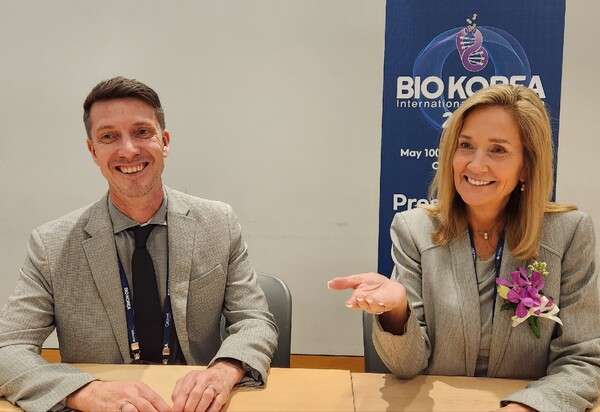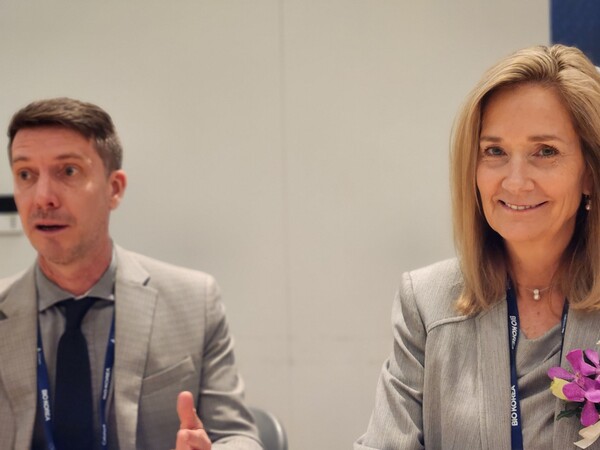In a promising development for the field of clinical research, the adoption of decentralized clinical trials (DCT) as a hybrid approach appears increasingly likely, said executives of IQVIA, the world’s largest clinical research organization (CRO).
The traditional investigator will always be at the center of clinical research for the lion’s share of clinical trial research, so there will be certain DCT assets used in addition to traditional care at the investigator site, they added.
These comments came from IQVIA’s President of Design and Delivery Innovation, Research & Development Solutions, Cynthia Verst, in an interview with Korea Biomedical Review, on the sidelines of BIO Korea 2023 on Wednesday.

Verst was also joined by her colleague, Jérôme Armellini, IQVIA’s Asia Head of Clinical Development & Operations Strategy, Research & Development Solutions. Both are carded to speak on patient centricity and the digital patient journey as well as DCT trends on Thursday at COEX.
Regarding this patient-centric approach, IQVIA Korea VP & General Manager Chung Su-yong emphasized that the goal of DCT adoption should be to improve treatment access for patients rather than the commercial aspect of competing with other countries.
How does DCT work?
The definition of DCT varies from stakeholder to stakeholder, Verst explained. “Essentially, it’s a clinical trial in which data collection, patient evaluation, and care are conducted outside of the traditional investigator site environment with the help of critical digital components.”
For example, it involves the patient’s ability to sign the informed consent form electronically versus paper-based documents at the investigator site. It also entails digital data collection via electronic clinical outcome assessments (ECOA) collected from laptops, smartphones, wearables, patches, and more.
“Traditionally, patients come to the investigator and return for follow-up assessments, but with DCT, they can receive nursing or phlebotomist visits at home to draw blood samples or other types of cultures,” the clinical trial expert said.
Alternatively, patients can be seen by local physicians or examined via telehealth methods which serve as the sub-investigator reporting to the primary investigator who is evaluating the patient remotely, Verst added.
Why is DCT important?

According to Verst, DCT offers a three-fold advantage: It gives patients greater access to clinical trial participation; it helps to accelerate clinical trial conduct; and lastly, it helps deliver more cost-effective clinical trial development.
"Overall, DCT is intended to dramatically reduce the burden on investigators and patients alike," she added.
Armellini chimed in with a patient perspective.
“DCT leverages digital tools and special services to do as much as you can at the patient’s home while placing the patient back at the center of clinical trials,” he said.
Asian countries are embracing DCT by deploying it as much as possible through guidelines and recommendation papers published by regulatory bodies and governments, he explained.
In this regard, he specifically highlighted Australia as a forerunner in adopting and deploying DCT solutions.
Verst added to these comments by saying that DCT should not be considered a finite offering but rather an amalgamation of different solutions. Therefore, each protocol and indication are country-specific as regulatory requirements differ and thus appropriate DCT components need to be selected and fit for purpose in that country.
In this regard, Verst maintained that DCT adoption heavily depends on each country’s regulation and guidance requirements in addition to the sponsor's willingness to adopt.
However, she mentioned that the biggest stimulus for DCT adoption is the regulator's guidance to adopt and deploy DCT capabilities. Still, she pointed out, “Many if not all regulatory guidance on DCT very clearly state that review and approval of new products will need to demonstrate the same efficacy and safety data sets as traditional clinical trials.”
On this note, Armellini also stated that regulatory bodies of Asian countries such as China, Japan, Taiwan, Malaysia, and Korea have already released final guidelines or draft recommendations in some cases.
“It’s going to be a three-pillar parameter equation consisting of regulations, sites, and sponsors,” explained Armellini. “It has to bring overall value so we have to assess what DCT component we can put forward in a very customized and flexible solution.”
The true catalyst will be the harmonization of regulatory guidance on DCT globally, said Verst.
DCT technologies, benchmarking, and patient centricity
Asked what kind of technologies are utilized in DCT, Verst replied, “In addition to telehealth, electronic informed consent forms, and ECOA, there is direct-to-patient digitalization which is used to access, recruit, retain, and engage patients. Lastly, the platform technology must ensure the interoperability of all the aforementioned technologies.”
IQVIA also makes use of modeling and simulations to leverage real-world data to focus the targeting of different omnichannel approaches to access patients and perform clinical trials, Verst added.
Given these tools, a successful DCT program then relies on the upfront protocol by design and the assessment of the protocol, the indication, country requirements, and the patient profile.
“The most successful DCT programs I have seen require proactive, preemptive planning with the patient voice in mind, and cannot be an afterthought,” she continued.
Armellini was also quick to note that as Korea is still developing its guidelines, the nation’s regulator can consider benchmarking from the EMA’s finalized DCT paper recommendations or the more recent U.S. FDA draft DCT recommendations.
Verst noted that IQVIA is incorporating the patient’s voice before, during, and after clinical trials. For example, she mentioned that IQVIA conducts patient panels where they bring the protocol-eligible patients and survey them seeking to understand their personas.
“We also conduct these surveys digitally through the clinical research website and seek their insights in terms of patient burden, how to optimize protocol design to attract a greater cohort of patients, and the ability to use these resources to better communicate with them during the trial using a "white glove” approach,” explained Verst.
Throughout the clinical trial, IQVIA also operates a patient portal to push and pull information, and subsequently, after the clinical trial, patients are invited to join IQVIA alumni to keep them involved in clinical research, she added.
Related articles
- Decentralized clinical trial emerges as irresistible trend. What about Korea?
- [Special] ‘Regulation’ blocks DCT introduction in Korea. So how to unravel tangled threads?
- [Special] DCT was behind 1st Covid-19 vaccine developed in just 1 year
- [Special] 'Be it US, Europe, or China, DCT is global trend in clinical trials'
- [Special] Decentralized clinical trial is not an option but a must
- How much can we condense vaccine manufacturing?
- Regulator ‘half-positive’ to digital healthcare firms' request to introduce DCTs
- JNP MEDI's pioneering role in DCT unveils enormous potential
- Korea's delay in decentralized clinical trials sparks global exclusion concerns: experts
- KoNECT unveils CRO certification results for 2023

